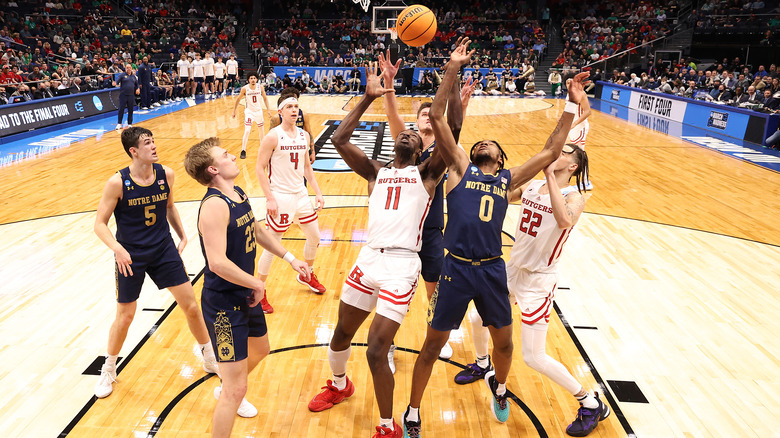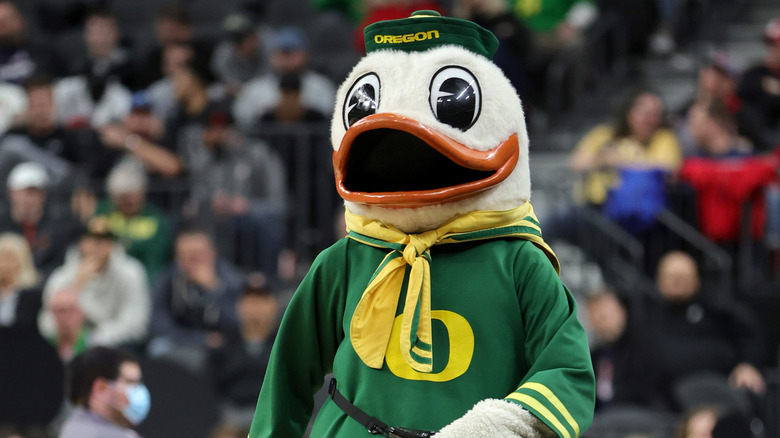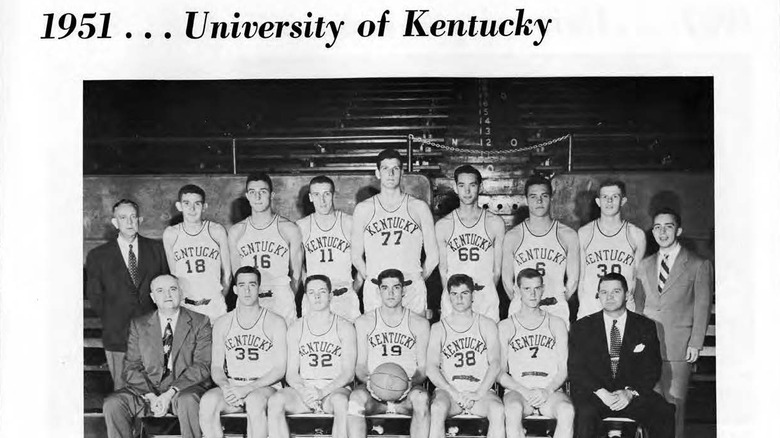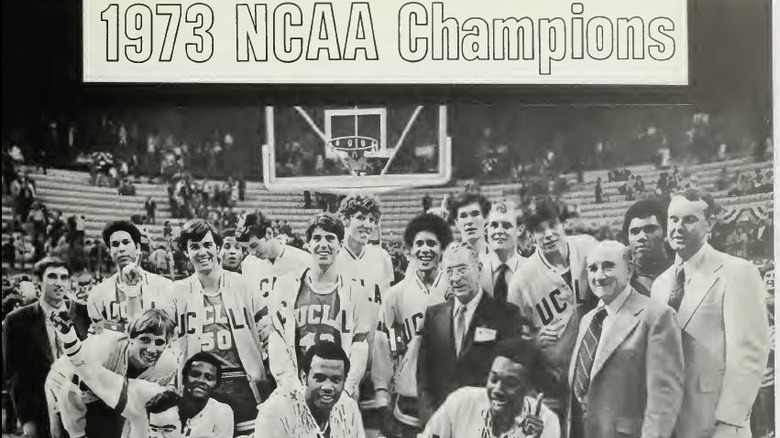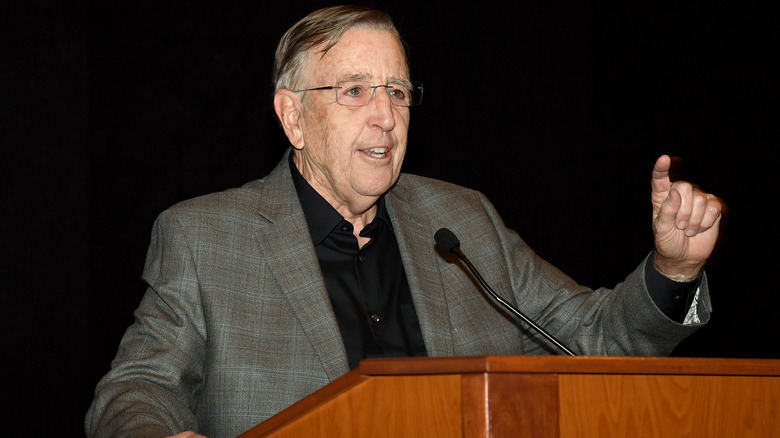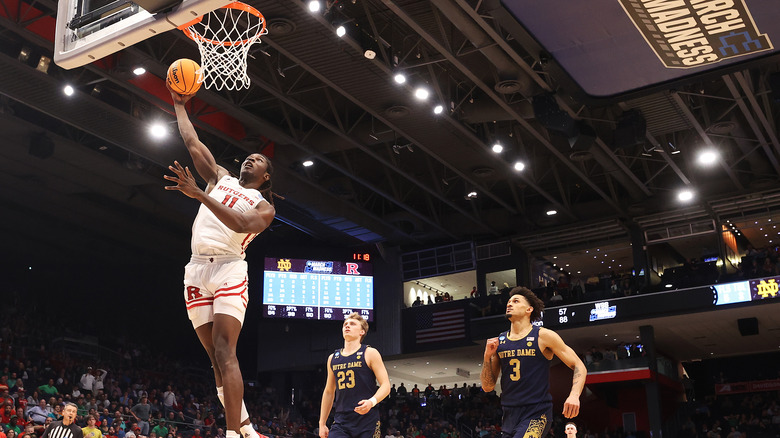When Was March Madness Expanded To 68 Teams?
For some people, March means the advent of spring, births under the sign of Pisces, or even the deathiversary of Julius Caesar on March 15 (beware the Ides of March!). But to many sports fans, it means only one thing: March Madness. Loved by armchair sportscasters, zealous statisticians, and fantasy bracket creators alike, March Madness is everyone's favorite alliterative, collegiate clash of the battle of the balls.
While the term "March Madness" definitely sounds like something invented during modern sports media hype train of flashy graphics, folks might be surprised to learn that the whole tournament has actually been around for over 80 years, starting with the Ducks beating the Buckeyes 46-33 in 1939, via the NCAA. Back then, there were only eight teams in the bracket, a huge difference from today's 68 teams. Granted, the number of universities in the United States more than doubled from 1939 to 1985, when the number of teams reached 64 (per the National Center for Educational Statistics, p. 75). As interest from the public grew, it stands to reason that university sports budgets grew (and university revenue), along with ad revenue (currently approaching $1 billion, per Statista), higher demand for skilled players, better training methods, and in the end, better games and more moolah for all.
So let's take a trip back through the 20th century and trace the history of March Madness as it grew from a fairly simple, low-key enterprise into the 68-team basketball bonanza it is today.
The Ducks won the first 8-team bracket in 1939
[old-timey radio announcer voice] The year is 1939. World War II will break out in September, everyone exists in black and white, and most shockingly of all: there are only eight teams in the NCCA Division I men's basketball tournament.
The winners of the first tournament, the Oregon Ducks, quacked through a 29-5 season leading up to a 46-33 victory against the Ohio State Buckeyes. At the time, brackets were split into western and eastern regions, while teams passed through a simplified three rounds: regional semifinals, regional finals, and then the national championship, via the NCAA.
We have assistant executive secretary of the Illinois High School Association, Henry V. Porter, to thank for coining the "March Madness" moniker. Porter, stunned by the feverish intensity surrounding the tournament, penned an absolutely hilarious article in March of 1939, for Illinois High School Athlete (totally worth quoting to some degree). Porter wrote, "Homo of the Hardwood Court is a hardy specie. There are millions of him. He exists through summer and fall, shows signs of animation through the winter, and lives to the utmost during March when a hundred thousand pairs of rubber-soled shoes slap the hardwood in a whirlwind of stops and pivots and dashes on the trail to the state basketball championships. He is a glutton for punishment. When the 'March madness' is on him, midnight jaunts of a hundred miles on successive nights make him even more alert the next day."
The number of teams doubled in 1951
Despite all the frothing madness described by Henry V. Porter, the NCAA (National Collegiate Athletic Association) didn't put on the biggest college basketball tournament until the 1950s, as History tells us. Through the 1940s, the NIT (National Invitation Tournament) ran the biggest show. The NIT was founded in 1938, a year earlier than the NCAA. And Porter, as it turns out, had borrowed "March Madness" from a local car dealership's spring sales slogans, via the Las Vegas Review-Journal.
As the NCAA grew in size, the number of teams available to join the NIT shrank. But even now, the NIT carries on in the wake of its bigger, burlier, more cash-flush brother with a 32-team bracket, as the NCAA explains. Their tournament simply goes first round, second round, quarterfinals, semifinals, and championship. Funny enough, though? The NCCA straight up purchased ownership rights to the NIT in 2005, anyway, as Britannica says.
In 1951, the NCAA saw its first expansion from eight teams to 16. It's unclear why the expansion occurred, but it raises a good question posed by the Bleacher Report. Namely, how are participating teams determined? Expanding the number of available slots to 16 means more teams can join in, but how do we ensure their quality and competitiveness? As it turns out, this role traditionally fell to the Associated Press men's basketball poll. In 1949, two years before the NCAA's expansion, the AP began ranking the league's best teams, year by year.
The number of teams doubled again in 1975
In 1953, two years after the NCAA got double-sized, the number of bracketed teams got a bump from 16 to 22, as the Bleacher Report explains. From that point, the tournament remained stable until 1975 when the number of teams doubled yet again to 32, same as the current NIT bracket.
It's unclear whether UCLA's seven-year winning streak from 1967-1973 (via the NCAA) had anything to do with 1975's size jump, but it's true that folks love leaping on the "support the dominant champions" bandwagon. The early 1970s, particularly '70 and '71, also saw a slew of standout performances that may have contributed to the NCAA's popularity, such as Austin Carr of Notre Dame scoring 47, 52, 52, and 61 points in various, single games within those two years. Future NBA-er Bill Walton picked up UCLA's point-scoring baton from Carr in '72 and '73, in the latter year once making 21 out of 22 shots against Memphis State, per History. Walton then went on to join the NBA in a time of legends like Kareem Abdul-Jabbar, forging deeper links between the NCAA and the pros, and further reinforcing the professionality of the NCAA, in turn.
Bleacher Report also speculates that the infusion of televisions into American homes between the '50s and '70s (and we're assuming buffalo wings) had something to do with it. More eyes glued to the tube meant more happy advertisers.
The number of teams doubled yet again in 1985
Now we get into a time of history perhaps known to readers more from memory than history books. Come 1985, what else was there to do with March Madness except make it even madder? In 1985, the NCAA saw its number of teams double yet again, from 32 to 64.
As an example of the power of catch phrases and slogans, the term "March Madness" helped propel the NCAA's popularity to new heights. Henry V. Porter might have first deployed the phrase back in the league's inaugural year in 1939, but it was broadcaster Brent Musburger who popularized the phrase in the early '80s, as the Las Vegas Review-Journal explains. In 1982, after CBS inherited the tournament from NBC, Musburger started saying, "It's madness, folks. This is March Madness," anytime there was some dramatic turnaround in a game. He also coined the phrase, "You are looking live," in reference to the league's games being aired live. Live games might have also helped to increase the drama of the entire experience.
March Madness' anthem, "One Shining Moment," first aired following the tournament in 1987, as the NCAA says. David Barret, writer of "One Shining Moment," said in a 2016 video on the March Madness YouTube channel, that he knew he "had a big one on the line" when he wrote the song. Former Duke head coach Mike Krzyzewski said of the tune, "It's the best song for any sport in the world."
Four more teams got tacked on from 1999-2011
At present, as fans can doubtlessly recite, the NCAA's regions and rounds have mutated to adapt to its current, colossal size. They've even incorporated some catchy names into the mix, to boot. We've got four regions: west, east, south, and midwest. We've also got first round, second round, Sweet 16, Elite 8, national semifinals, and then national championship.
The road from a sensibly doubled 64 teams to March Madness' current 68 teams is a bit wacky and weird. As the NCAA states, the changeup started in 1999 when the Mountain West conference joined division 1. Come the next season, the division's teams got automatically incorporated into the NCAA tournament, which had the unfortunate consequence of funking up the tournament's numbers. The amount of automatically qualifying teams went up to 31, and the total teams to 65. To balance things out, the NCAA added an opening round to the mix, which pitted the lowest two ranking teams against each, and plugged the winner into the first round of the tournament.
Come 2011, as the NCAA goes on to explain, the league expanded this opening round into a full-on, even-numbered mini-tournament dubbed, "the first four." Now, the winners of these initial four games all get plugged into the first round of the greater March Madness tournament according to their region. And, seeing as its roundabouts mid-March right now, time to have at those fantasy brackets and get mad, folks.
